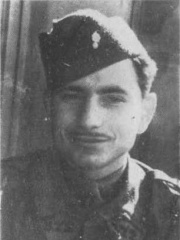

The Most Famous
PHYSICISTS from Latvia
This page contains a list of the greatest Latvian Physicists. The pantheon dataset contains 717 Physicists, 2 of which were born in Latvia. This makes Latvia the birth place of the 40th most number of Physicists behind Mexico and Finland.
Top 2
The following people are considered by Pantheon to be the most legendary Latvian Physicists of all time. This list of famous Latvian Physicists is sorted by HPI (Historical Popularity Index), a metric that aggregates information on a biography’s online popularity.

1. Anatole Abragam (1914 - 2011)
With an HPI of 50.65, Anatole Abragam is the most famous Latvian Physicist. His biography has been translated into 21 different languages on wikipedia.
Anatole Abragam (15 December 1914 – 8 June 2011) was a French physicist who wrote The Principles of Nuclear Magnetism and made significant contributions to the field of nuclear magnetic resonance. Originally from Griva, Courland Governorate, Russian Empire, Abragam and his family emigrated to France in 1925.

2. Juris Upatnieks (1936 - )
With an HPI of 43.78, Juris Upatnieks is the 2nd most famous Latvian Physicist. His biography has been translated into 15 different languages.
Juris Upatnieks (born 7 May 1936 in Riga) is a Latvian-American physicist and inventor, and pioneer in the field of holography. Upatnieks fled the Latvia with his parents at the close of World War II, seeking asylum in Germany. In 1951 the family emigrated to the United States. He attended high school in Akron, Ohio, and studied electrical engineering at the University of Akron, where he was awarded a bachelor's degree in 1960. Thereafter he studied at the Institute of Science and Technology of the University of Michigan, where he earned a master's degree in electrical engineering in 1965. From 1973 to 1993 he worked at the Environmental Research Institute of Michigan and was an Adjunct Professor, Electrical and Computer Engineering Department at University of Michigan in Ann Arbor. There he taught a laboratory course in optics until 1996. From 1993 to 2001 he was a consultant with Applied Optics in Ann Arbor. From 1996 to 2001 he was also a researcher with the faculty of Mechanical Engineering and Applied Mechanics at the University of Michigan. In 1964 he demonstrated, with Emmett Leith, the first three-dimensional holograms in the United States and together with Leith published a series of technical papers from 1962 to 1964. As of 2009 Upatnieks holds 19 patents. Among them is an holographic gunsight. In 1975 he received the R. W. Wood Prize of the Optical Society of America and 1976 the Holley Medal of the American Society of Mechanical Engineers. He was named "Inventor of the Year" in 1976 by the American Association for the Advancement of Invention and Innovation. He is a member of the Optical Society and of International Society for Optical Engineering, as well as a member of the Latvian Academy of Sciences, whose Great Medal he received in 1999.
Pantheon has 2 people classified as physicists born between 1914 and 1936. Of these 2, 1 (50.00%) of them are still alive today. The most famous living physicists include Juris Upatnieks. The most famous deceased physicists include Anatole Abragam. As of April 2022, 1 new physicists have been added to Pantheon including Juris Upatnieks.







